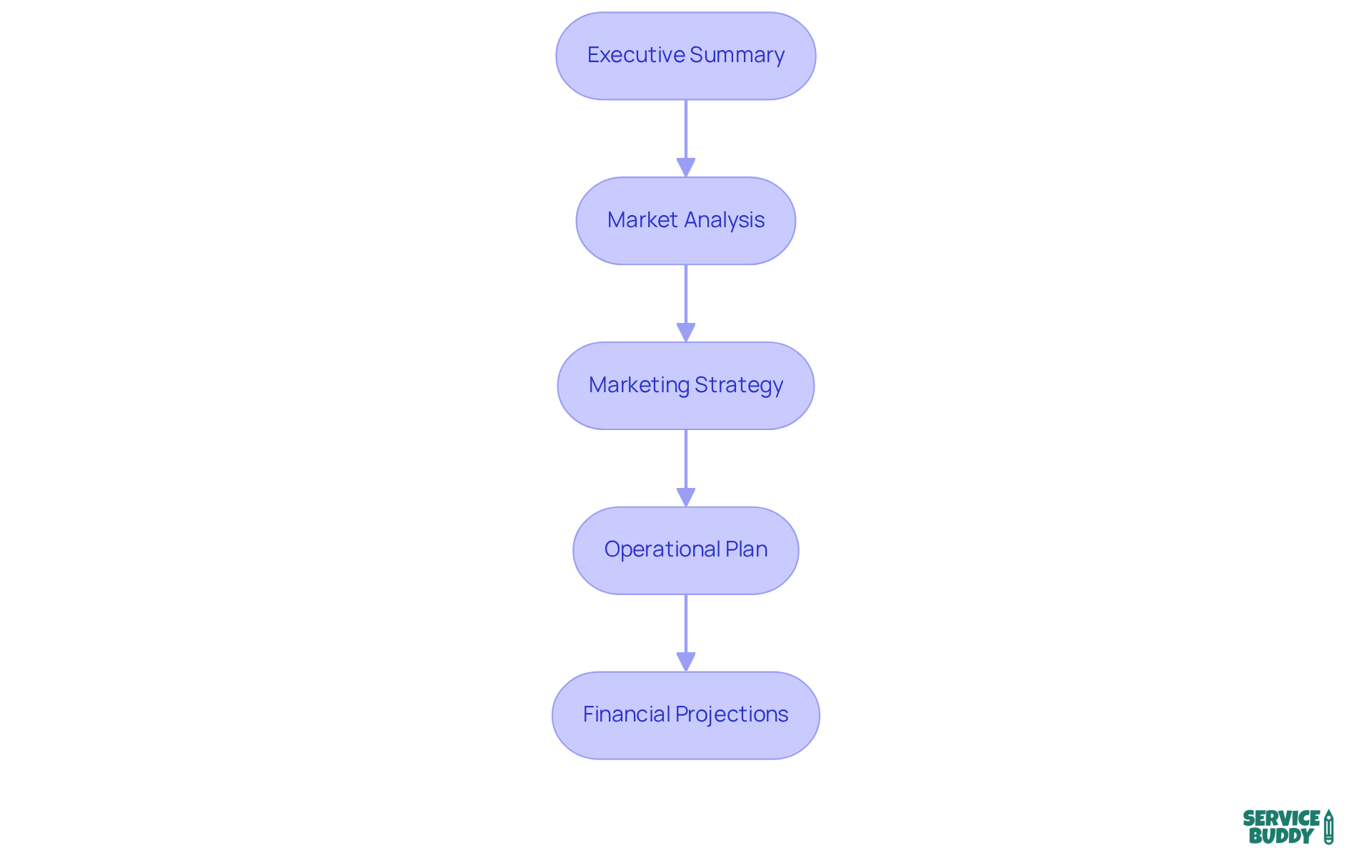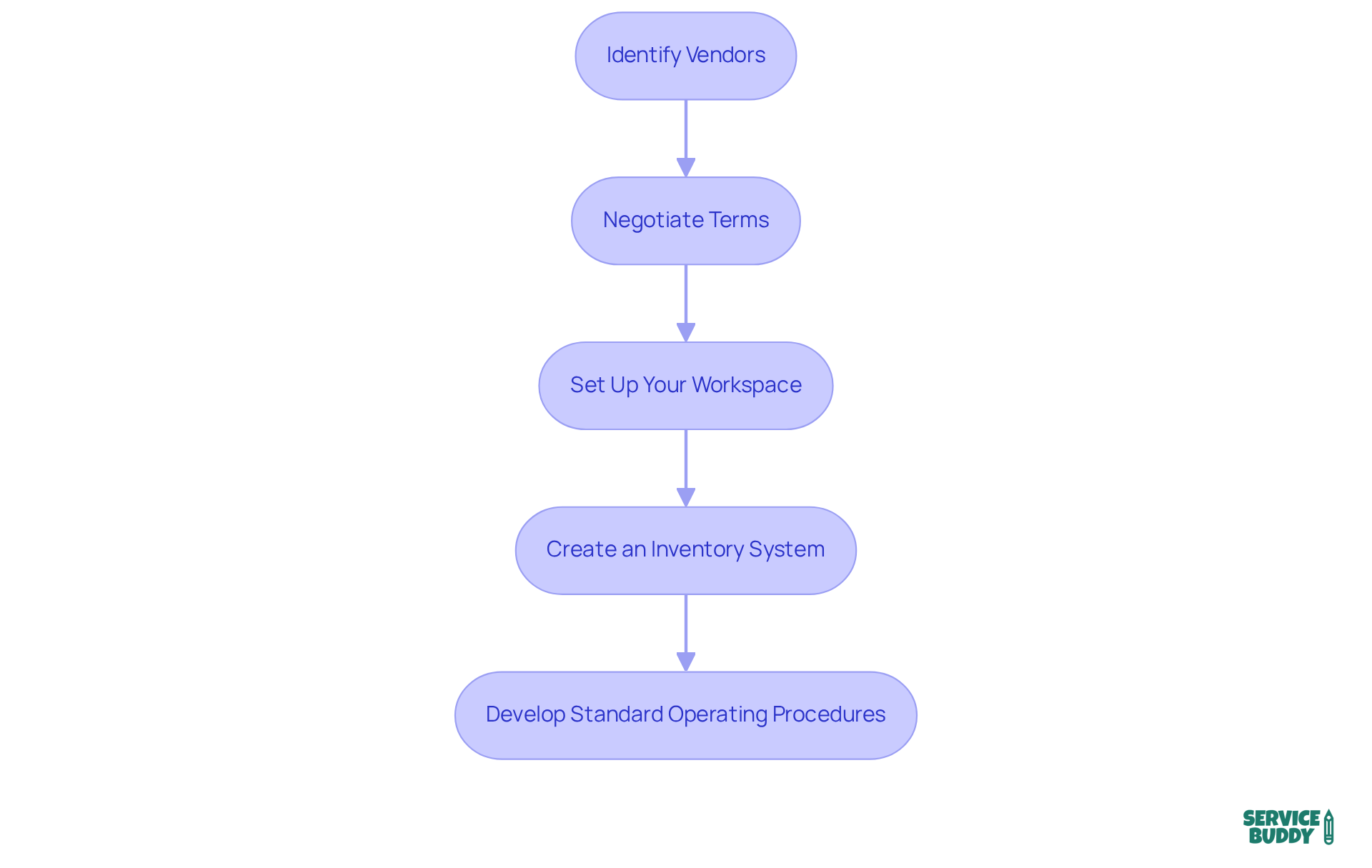4 Steps to Launch Your Flooring Business Successfully
Unlock your potential with a step-by-step guide to successfully launch your business flooring venture.

Introduction
Launching a flooring business is not just a venture; it’s an opportunity to carve out a unique space in a competitive market. However, success hinges on careful planning and strategic execution. Entrepreneurs must navigate a myriad of essential steps, from crafting a robust business plan to implementing effective marketing strategies. What key components can make or break your flooring business launch? How can you ensure that you stand out in a crowded marketplace?
This guide delves into the critical steps necessary for a successful flooring business launch. It provides valuable insights and actionable strategies designed to turn your dreams into reality. By understanding the landscape and preparing effectively, you can position yourself for success in this dynamic industry.
Develop a Comprehensive Business Plan
To develop a comprehensive business plan for your flooring business, follow these essential steps:
-
Executive Summary: Start with a concise overview of your business. Include your mission statement and the specific services you will offer. This section serves as a roadmap, guiding your decisions and strategies.
-
Market Analysis: Conduct thorough research on business flooring in the flooring industry. Identify your target audience and analyze competitors to understand market dynamics. Tools like surveys and industry reports can provide valuable insights into client preferences and trends. Remember, understanding demand is crucial for effective marketing.
-
Marketing Strategy: Outline your approach to attracting and retaining customers. This should encompass digital marketing initiatives, local advertising efforts, and potential collaborations with complementary enterprises.
-
Operational Plan: Detail the daily operations of your enterprise, including staffing requirements, supplier relationships, and logistics. Specify how you will manage projects and maintain customer relationships to ensure smooth operations. Introduce key members of your management team and their relevant experience, as this can enhance credibility and trust with potential investors and clients.
-
Financial Projections: Create a comprehensive budget that outlines startup costs, projected income, and ongoing expenses. In 2025, average startup expenses for flooring companies can vary significantly based on the services provided and the model selected. This financial framework will help you forecast performance over the first few years, allowing for necessary adjustments. Most new enterprises require some upfront capital, so planning for these costs is essential. Consistently examining and revising your plan as your enterprise develops is crucial for sustained success.
A well-organized business plan not only aids in obtaining funding but also acts as a strategic roadmap for growth and achievement in a competitive market. A strong strategy forms the backbone of any successful business flooring endeavor.

Choose a Business Structure and Obtain Licenses
Choosing the right business structure and obtaining the necessary licenses is crucial for your business flooring venture. Here’s how to navigate this process effectively:
-
Research Business Structures: Start by evaluating your options—sole proprietorship, partnership, LLC, or corporation. Each structure has its own implications for liability, taxation, and management. Which one aligns best with your business goals?
-
Consult a Professional: Don’t go it alone. Speak with a legal or financial advisor who can help you understand the nuances of each structure. Their expertise will guide you in selecting the best fit for your unique situation.
-
Register Your Company: After deciding on a structure, it’s time to register your company name with the relevant state or local authorities. This step is essential to establish your business legally.
-
Acquire Required Licenses: Investigate the permits necessary for business flooring enterprises in your area. This may include a general business license, a contractor's license, and specific permits related to the installation of floor coverings. Are you aware of all the licenses you need to operate legally?
-
Stay Compliant: Compliance doesn’t stop after registration. Make sure you understand ongoing requirements, such as renewals and additional permits for specific projects. Staying informed will save you from potential legal issues down the line.
By following these steps, you’ll lay a solid foundation for your flooring business, ensuring you’re well-prepared to tackle operational challenges head-on.

Source Materials and Set Up Operations
To successfully source materials and establish operations, follow these essential steps:
-
Identify Vendors: Start by conducting thorough research to find flooring material providers that offer high-quality products at competitive prices. Prioritize nearby vendors to benefit from quicker delivery times, enhancing your project timelines.
-
Negotiate Terms: Engage in discussions about pricing, delivery schedules, and payment terms. Building solid connections with vendors can lead to better agreements as your business grows. Effective negotiation can significantly impact your bottom line, so be prepared to advocate for favorable terms. As Eric Thompson, Owner of Satolli Carpet & Floor Covering, wisely advises, "Don't settle for the first supplier you encounter; compare prices from various providers to discover the best offers."
-
Set Up Your Workspace: Decide whether your operations will be based in a physical location or a home office. Ensure you have all necessary tools and equipment for surface installation, as this directly affects your efficiency and service quality.
-
Create an Inventory System: Implement a robust inventory management system to track materials and supplies. This practice not only helps manage expenses but also ensures you have the essential resources for each project, reducing delays and improving client satisfaction. The resilient flooring category generated $8.381 billion in 2024, underscoring the importance of effective inventory management in a competitive market.
-
Develop Standard Operating Procedures: Establish clear processes for project management, client communication, and quality control. This ensures consistency and efficiency in your operations, ultimately leading to better service delivery and client retention. Referencing successful case studies, such as AHF Products' acquisition of the Wellmade facility, can provide valuable insights into how strong supplier relationships enhance operational capabilities.

Implement Effective Marketing Strategies
To implement effective marketing strategies, follow these steps:
-
Define Your Target Audience: Start by identifying your ideal clients. Examine demographics, location, and specific surface requirements. With millions of homeowners planning business flooring projects each year, effectively targeting your marketing efforts is crucial to engage this potential market.
-
Build an Online Presence: Establish a professional website that highlights your services, showcases completed projects, and features client testimonials. Optimize your site for search engines to increase visibility and attract organic visitors. Remember, 92% of searchers select companies on the first page of results. Incorporating trust signals, such as displaying ratings like '4.8 stars on Google,' can significantly enhance your credibility.
-
Utilize Social Media: Leverage platforms like Instagram and Facebook to showcase your work. Share compelling before-and-after images, client stories, and flooring tips to foster engagement and build a community around your brand. As Richard Uzelac emphasizes, setting distinct goals for your digital campaigns can help you stand out from the competition.
-
Network Locally: Participate in local home improvement shows, join business associations, and collaborate with real estate agents to generate referrals and boost your visibility in the community.
-
Offer Promotions: Consider introductory offers or discounts for first-time customers to incentivize them to choose your services. Additionally, utilize email marketing, which is one of the most profitable digital marketing strategies for business flooring companies, yielding an average ROI of 4400%. This approach helps maintain connections with past clients and keeps them informed about new promotions and offerings.

Conclusion
Successfully launching a flooring business demands a strategic approach that covers various aspects of entrepreneurship. Start by crafting a comprehensive business plan, selecting the right business structure, sourcing quality materials, and implementing effective marketing strategies. These steps position aspiring business owners for success in a competitive market.
Essential actions include:
- Conducting market analysis to grasp customer needs
- Establishing strong vendor relationships for material sourcing
- Creating a robust online presence to attract clients
Each of these components is vital in building a solid foundation for your business, ensuring operational efficiency, and enhancing customer engagement.
The journey to a thriving flooring business begins with meticulous planning and execution. By addressing these critical areas, entrepreneurs can navigate the complexities of starting a business and set themselves on a path toward long-term growth and profitability. Embracing these practices empowers flooring professionals to stand out in the industry and meet the evolving demands of their clients.
Frequently Asked Questions
What is the purpose of an executive summary in a business plan?
The executive summary provides a concise overview of the business, including the mission statement and specific services offered. It serves as a roadmap for guiding decisions and strategies.
How can I conduct a market analysis for my flooring business?
To conduct a market analysis, research the flooring industry, identify your target audience, and analyze competitors. Tools like surveys and industry reports can help gather insights into client preferences and trends.
What should be included in the marketing strategy of a flooring business?
The marketing strategy should outline the approach for attracting and retaining customers, including digital marketing initiatives, local advertising efforts, and potential collaborations with complementary enterprises.
What details should be covered in the operational plan?
The operational plan should detail daily operations, including staffing requirements, supplier relationships, logistics, project management, and customer relationship maintenance. It should also introduce key management team members and their relevant experience.
What are financial projections, and why are they important?
Financial projections involve creating a comprehensive budget that outlines startup costs, projected income, and ongoing expenses. They are important for forecasting performance, planning for necessary adjustments, and obtaining funding.
Why is it essential to revise the business plan regularly?
Regularly revising the business plan is crucial for sustained success, as it allows for adjustments based on the enterprise's development and changing market conditions.
How does a well-organized business plan benefit a flooring business?
A well-organized business plan aids in obtaining funding and acts as a strategic roadmap for growth and achievement in a competitive market, forming the backbone of a successful flooring endeavor.
List of Sources
- Develop a Comprehensive Business Plan
- floortrendsmag.com (https://floortrendsmag.com/articles/113307-how-2025-is-reshaping-the-flooring-industry)
- floortrendsmag.com (https://floortrendsmag.com/articles/109484-how-to-start-your-flooring-business-plan)
- lightspeedhq.com (https://lightspeedhq.com/blog/how-to-start-a-flooring-business)
- qprosoftware.com (https://qprosoftware.com/blog/business-management/ten-things-to-include-in-a-flooring-business-plan.min.html)
- franchise.prosourcewholesale.com (https://franchise.prosourcewholesale.com/blog/flooring-business)
- Choose a Business Structure and Obtain Licenses
- lightspeedhq.com (https://lightspeedhq.com/blog/how-to-start-a-flooring-business)
- zenbusiness.com (https://zenbusiness.com/business-license-costs)
- business.nextdoor.com (https://business.nextdoor.com/en-us/blog/how-to-start-a-flooring-business)
- Source Materials and Set Up Operations
- fcnews.net (https://fcnews.net/2025/11/top-20-distributors-2025)
- Scoring flooring: Industry stats for 2024 - Floor Covering News (https://fcnews.net/2025/06/scoring-flooring-industry-stats-for-2024)
- floortrendsmag.com (https://floortrendsmag.com/articles/113297-2025-new-flooring-products-guide)
- floorcoveringweekly.com (https://floorcoveringweekly.com/prg/covid-19-updates/top-20-distributors-of-2025-45746)
- satollicarpet.com (https://satollicarpet.com/smart-strategies-for-purchasing-affordable-new-floors)
- Implement Effective Marketing Strategies
- dolead.com (https://dolead.com/growth-hub/flooring-advertising-ideas-winning-strategies-for-2025)
- bestversionmedia.com (https://bestversionmedia.com/a-guide-for-local-flooring-companies-to-dominate-neighborhood-searches)
- gomarketing.com (https://gomarketing.com/blog/digital-marketing-strategies-for-flooring-companies)
- floortrendsmag.com (https://floortrendsmag.com/articles/113079-digital-marketing-reshapes-flooring-retail-success-strategies)
- growthteams.com (https://growthteams.com/grow-flooring-business-2025)
See Service Buddy in action with a live demo
Everything you need to run your flooring business, Service Buddy is your all-in-one management platform.




.svg)